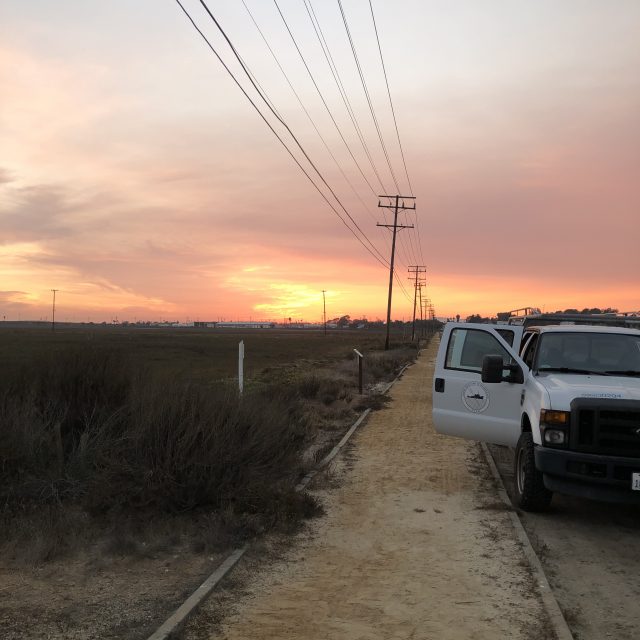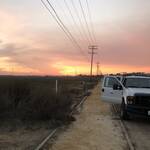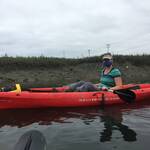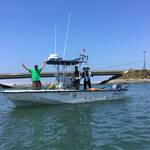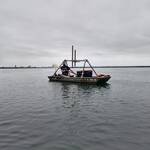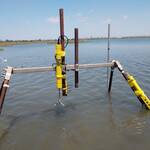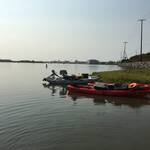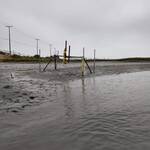Dr. Emily Lemagie started with the lab in December 2020. She will be working on an NSF CAREER award investigating the relative role of oceanic forcing on estuarine exchange flow. Her background and expertise in estuarine science, river plume dynamics, inner-shelf dynamics, and science communication is an excellent fit for this project. She completed her PhD in Physical Oceanography at Oregon State University in 2018 working with Dr. Jim Lerczak and worked as a postdoctoral scholar at the Woods Hole Oceanographic Institution with Dr. Anthony Kirincich and Dr. Steve Lentz before joining our group in December 2020.
most Seal Beach instrumentation recovered!
Most of our instruments in the Seal Beach National Wildlife Refuge and Huntington Harbor were successfully recovered! A few instruments remain to continue our study to assess marsh response to human alterations. This project is in collaboration with the Seal Beach National Wildlife Refuge, Naval Weapons Station Seal Beach, and Naval Facilities Engineering Command Southwest.
- finishing up at sunset due to the late low tides!
new postdoctoral scholar, Dr. Brasseale!
Dr. Elizabeth Brasseale joined our lab in late September 2020. She will be working on a US Coastal Research Program (USCRP) project examining pollution transport including improving predictions in the Southern California region and beyond. She recently finished her PhD at the University of Washington working with Parker MacCready on estuarine-shelf interactions and larval transport of marine invasive species in the Pacific Northwest.
new postdoc position in Giddings lab!
This position is now closed.
Postdoc in oceanic forcing of estuarine exchange at Scripps Institution of Oceanography, UCSD
The Scripps Institution of Oceanography (SIO) Center for Coastal Studies, UCSD, is looking for a postdoctoral scholar to work on an NSF-funded project aiming to improve our understanding of the importance of remote oceanic forcing on estuarine exchange flow across estuarine parameter space. The postdoctoral scholar will be responsible for building upon a series of existing realistic regional numerical models over multiple hindcast years, conducting some semi-idealized simulations, and analyzing estuarine exchange flow across estuarine parameter space. A strong background in oceanography is required and preference will be given to those with significant expertise in numerical modeling. Most of the existing available regional numerical models use the ROMS framework, however, several are spread across different regional hydrodynamic codes (including SCHISM, GETM, SUNTANS, and FVCOM), thus significant experience across different coding languages is desirable. The position will be located at SIO working with Dr. Sarah Giddings, with opportunities to mentor graduate and undergraduate students. Moreover, there will be opportunities for interaction with scientists worldwide who are contributing model output. This particular position and project is entirely focused on numerical modeling, however, there will likely be opportunities to participate in field work within the Giddings laboratory and potentially other groups at SIO. Finally, if desired, the postdoctoral researcher will have the ability to participate in the project’s significant outreach component, including helping to implement and design an interactive visualization tool for numerical simulations. Additional information and application instructions for this postdoctoral position can be found here.
new paper on Yanai Waves in the equatorial Indian Ocean
Dr. Arzeno’s paper in GRL on the generation of quasi-biweekly Yanai waves in the equatorial Indian Ocean is now published in early view. This is a really unique paper where Isa has used satellite sea surface height and wind velocity data to assess the characteristics and generation of Yanai waves in the equatorial Indian Ocean. Prior literature used numerical models to investigate these waves and very sparse moorings. Using a technique that Isa optimized we are able to show the full structure of the wave across the Indian Ocean basin and quantify important wave characteristics. This work is a departure from my lab’s typical smaller-scale coastal work and is a testament to Isa’s amazing growth and independence as a scientist. Working on something this different was fun and inspiring for all of us!
fieldwork in Seal Beach National Wildlife Refuge
As part of a project to assess marsh response to human alterations, over the past few weeks we have deployed a series of moorings in the Seal Beach National Wildlife Refuge. This project is in collaboration with the Seal Beach National Wildlife Refuge, Naval Weapons Station Seal Beach, and Naval Facilities Engineering Command Southwest. Doing all of this work socially distanced, chasing break of dawn low tides, and in sinking mud, has been very challenging but things are now all in place!
- Christine Whitcraft CSULB helping us out
- Greg taking a GPS point
- instrument frame pre-deployment
- field crew post-deployment
- Chloe helping us deploy vector frames
- ADV ready to be submerged!
- social distanced fieldwork = lots of boats
- eroding salt-marsh edge
- followup check at a lower-low tide found this frame high and dry (as planned) as well as sunken!
salt-wedge estuary paper published!
“Seasonal Changes in Structure and Dynamics in an Urbanized Salt Wedge Estuary” by Maggie McKeon, Alex Horner-Devine, and Sarah Giddings was just published in Estuaries & Coasts. This paper describes hydrographic measurements of a salt-wedge estuary, the Duwamish River Estuary, spanning a 20-fold range in seasonal discharge. The tidal dynamics are well explained by two-layer hydraulic theory, and result in a flood/ebb asymmetry that is modulated seasonally. This is an important result as it suggests that this type of estuary may exhibit a seasonally modulated residual circulation.
new paper on mid- to outer-shelf transport
“Mechanisms of Mid- to Outer-Shelf Transport of Shoreline-Released Tracers” was just released in the Journal of Physical Oceanography. This paper, led by postdoc Xiaodong Wu, focuses on exchange of a shore-line released tracer from the mid- to outer-shelf. While along-shelf flows are primarily driven by obliquely incident waves, cross-shore flows are are driven by both wind-driven Ekman transport and submesoscale frontal flows. A second paper focusing on the submesoscale fronts is in the works!
AUV observations of tidal flow over a coral reef paper
“Cross‐Shore Structure of Tidally‐Driven Alongshore Flow over Rough Bathymetry” manuscript published on-line in Journal of Geophysical Research, Oceans! This paper, led by former graduate student Andre Amador, uses autonomous underwater vehicle (AUV) data to examine the cross-shore structure of along-shore flow over a coral reef. Transport of heat, mass, and momentum over the inner-shelf impacts coastal distributions of larvae, nutrients, pollutants, and many other constituents. In this paper, AUV data shows a cross-shore structure of along-shore tidal flow that is well described with a simple momentum balance where friction becomes more important with proximity to shore. The paper further is able to estimate the bottom drag and roughness and show that the flow is dominated by longer wavelength roughness features. This paper combines an impressive array of data through a tidal phase average and compares it to a simple theoretical balance.

